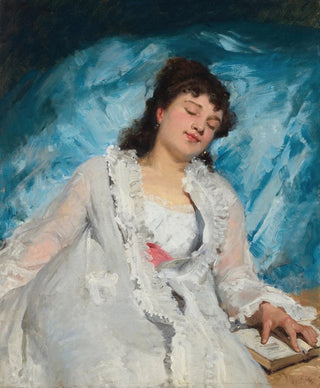Art print | Gentle Rest - Victor Gabriel Gilbert


View from behind

Frame (optional)
In the vast panorama of art history, certain works manage to capture the very essence of tranquility and everyday beauty. "Doux repos" by Victor Gabriel Gilbert is one of those creations that transports us into a universe imbued with serenity. This piece, created at the end of the 19th century, evokes a delicate pause, a moment of sweetness where the outside world seems to fade away. Through the depiction of a young woman asleep, the artist invites us to contemplate the fleeting beauty of life, to appreciate these moments of respite that nourish our soul. The soft light bathing the scene, along with the meticulous details, make this composition a true visual poem, an ode to inner peace.
Style and uniqueness of the work
Victor Gabriel Gilbert's style is distinguished by his ability to blend realism and impressionism. In "Doux repos," the artist employs a palette of delicate colors, where pastel shades harmoniously intertwine to create a soothing atmosphere. Every brushstroke appears charged with emotion, revealing not only Gilbert's mastered technique but also his deep attachment to depicting everyday life. The posture of the young woman, her flowing hair, and the drapes of her clothing are all elements that testify to the artist's skill in capturing beauty in simplicity. The composition, carefully balanced, guides the viewer's gaze toward the serene face of the protagonist, inviting gentle and contemplative introspection.
The artist and his influence
Victor Gabriel Gilbert, born in 1847, made his mark on his era with his innovative approach to genre painting. His work, rich in emotion and sensitivity, is part of an artistic movement that values daily life and intimate scenes. Influenced by his contemporaries, Gilbert was also a fervent admirer of the old masters, from whom he drew inspiration to develop his own style. His career, marked by exhibitions and distinctions, testifies to the impact he had on his peers and subsequent generations. By redefining how scenes of daily life can be represented,

Matte finish

View from behind

Frame (optional)
In the vast panorama of art history, certain works manage to capture the very essence of tranquility and everyday beauty. "Doux repos" by Victor Gabriel Gilbert is one of those creations that transports us into a universe imbued with serenity. This piece, created at the end of the 19th century, evokes a delicate pause, a moment of sweetness where the outside world seems to fade away. Through the depiction of a young woman asleep, the artist invites us to contemplate the fleeting beauty of life, to appreciate these moments of respite that nourish our soul. The soft light bathing the scene, along with the meticulous details, make this composition a true visual poem, an ode to inner peace.
Style and uniqueness of the work
Victor Gabriel Gilbert's style is distinguished by his ability to blend realism and impressionism. In "Doux repos," the artist employs a palette of delicate colors, where pastel shades harmoniously intertwine to create a soothing atmosphere. Every brushstroke appears charged with emotion, revealing not only Gilbert's mastered technique but also his deep attachment to depicting everyday life. The posture of the young woman, her flowing hair, and the drapes of her clothing are all elements that testify to the artist's skill in capturing beauty in simplicity. The composition, carefully balanced, guides the viewer's gaze toward the serene face of the protagonist, inviting gentle and contemplative introspection.
The artist and his influence
Victor Gabriel Gilbert, born in 1847, made his mark on his era with his innovative approach to genre painting. His work, rich in emotion and sensitivity, is part of an artistic movement that values daily life and intimate scenes. Influenced by his contemporaries, Gilbert was also a fervent admirer of the old masters, from whom he drew inspiration to develop his own style. His career, marked by exhibitions and distinctions, testifies to the impact he had on his peers and subsequent generations. By redefining how scenes of daily life can be represented,






